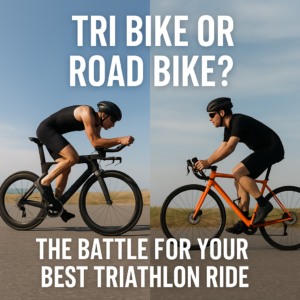
Are you riding the right bike for your triathlon goals?
Whether you’re prepping for your first sprint or eyeing a long-course PR, the bike you choose can make or break your experience—and your results. Time trial (TT) bikes and road bikes both have their place in the sport, but knowing when to ride which could mean the difference between cruising past your competition or cramping at mile 40.
Let’s break down the benefits (and not-so-benefits) of both. Stick with this post to the end—you’ll get clarity, confidence, and maybe even save a few hundred watts… and dollars.
🏁 The Case for the TT Bike: Built for Speed
1. Aerodynamics = Free Speed
TT bikes are designed with one goal in mind—slice through the wind. The geometry puts you lower and longer, reducing drag and making you faster at the same effort. In a flat, non-drafting triathlon, a properly fitted TT bike could save you 3 to 5 minutes over 40K. That’s real, measurable speed without extra training.
2. Power Positioning
The aggressive frame geometry isn’t just for looks. TT bikes open up your hip angle while you’re in aero, letting you produce power more efficiently without wrecking your run form. When done right, the transition from bike to run feels smoother.
3. Nutrition Access
Integrated hydration and nutrition storage is common on tri bikes. That means less reaching, more fueling, and better focus when it counts most—on race day.
🛑 The Not-So-Great Side of TT Bikes
1. Pricey and Less Versatile
TT bikes aren’t cheap. And while they’re great for straight-line solo racing, they’re not built for group rides, climbing, or casual long rides. If you’re only doing a couple races a year, it’s hard to justify a $3,000+ machine that collects dust 11 months out of the year.
2. Handling Can Be Tricky
The geometry that makes TT bikes fast also makes them less stable, especially on technical descents or in crosswinds. For beginners, this can lead to tense rides, braking too often, or avoiding aero altogether (which defeats the point).
3. Fit is Critical (and Sometimes Frustrating)
A TT bike demands a dialed-in fit. A poor setup can lead to numb hands, neck pain, or hamstring tightness—and make you dread every ride. Fitting a TT bike isn’t just swapping parts, it’s a science.
🚴 The Case for the Road Bike: Comfort, Control, and Confidence
1. Ideal for Beginners and Hilly Courses
Road bikes are more forgiving. You sit more upright, giving you better visibility and control. If you’re doing a race with technical turns or lots of climbing, a road bike may actually be faster and safer.
2. Comfort = Consistency
You’re more likely to ride often and longer on a bike that feels comfortable. Road bikes are easier to jump on for training, group rides, and commuting. That builds confidence and fitness—without the stress of aero positioning.
3. Cost-Effective and Versatile
You can find a great road bike for less money than an entry-level TT bike. Plus, it can serve multiple purposes: triathlon training, century rides, coffee shop cruising. One bike to rule them all (at least until the bug for speed bites harder).
⛔ The Road Bike Trade-Offs
1. Aero Limitations
No matter how much you hunch over, a road bike with clip-on bars won’t match the aero gains of a TT setup. That means lost time on flat courses or when riding into a headwind.
2. Positioning Can Strain the Run
Road bikes tend to keep your hips more closed compared to tri bikes. This may leave your legs feeling more fatigued heading into the run, especially in long-course racing.
3. Harder to Carry Fuel and Gear
Triathlon-specific storage and hydration systems don’t integrate as easily onto road bikes. This can make nutrition strategy more cumbersome, especially in half or full Iron distance events.
🧠 The Smart Move: Choose Based on You
Ask yourself:
-
Are you training mostly solo or in groups?
-
How comfortable are you riding in an aggressive aero position?
-
What does your race calendar look like?
-
Is your focus performance, comfort, or versatility?
-
Can you invest in a good bike fit and gear?
If you’re early in your triathlon journey, a road bike can be the perfect all-arounder. But once you’re chasing time goals and doing flat, non-drafting races—a TT bike might be your secret weapon.
🚨 Final Thought: It’s Not Just the Bike. It’s the Engine.
A $5,000 TT bike won’t do much if it sits on the trainer. But a well-ridden road bike, matched with smart training and fueling, can turn you into a podium contender.
Your bike is your tool. Choose the one that helps you ride more often, race with confidence, and love the process.
Want help deciding which bike is right for your goals?
Reach out for a personalized consult at [email protected]. You’ll get an honest answer—no bike snobbery here.

